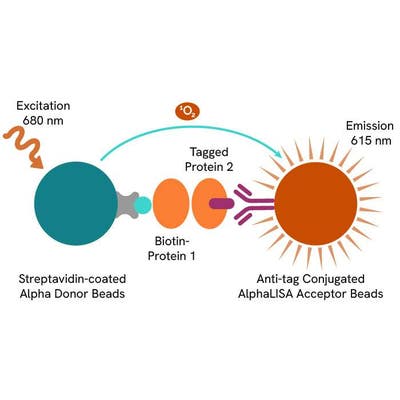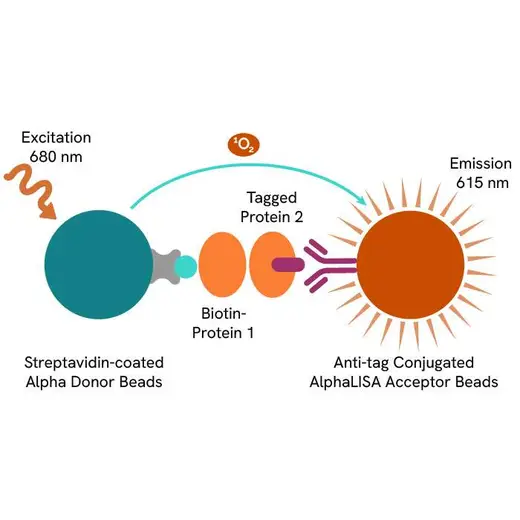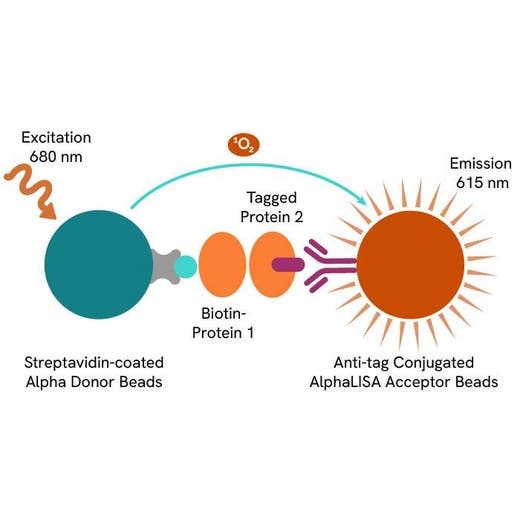
AlphaLISA Human HLA-DRA/LAG3 Binding Kit, 5,000 Assay Points


AlphaLISA Human HLA-DRA/LAG3 Binding Kit, 5,000 Assay Points






This kit is designed for the detection of binding activity between Human HLA-DRA and LAG3, using a homogeneous AlphaLISA assay (no wash step). This assay can facilitate the design and development of antibody therapeutics by using competitive binding to HLA-DRA and LAG3.
| Feature | Specification |
|---|---|
| Application | Protein-Protein Interaction |
| Sample Volume | 5 µL |
This kit is designed for the detection of binding activity between Human HLA-DRA and LAG3, using a homogeneous AlphaLISA assay (no wash step). This assay can facilitate the design and development of antibody therapeutics by using competitive binding to HLA-DRA and LAG3.



AlphaLISA Human HLA-DRA/LAG3 Binding Kit, 5,000 Assay Points



AlphaLISA Human HLA-DRA/LAG3 Binding Kit, 5,000 Assay Points



Product information
Overview
Features:
- No-wash steps, no separation steps
- Ease-of-use: few addition steps, fast assay development
- Broad range of affinities: detect strong or weak interactions, from pM to mM affinity
- Distance: measure very large protein or antibody complexes – spanning up to 200 nm or more
- High avidity: multiple binding sites on each bead enables use of nanomolar concentrations of antibodies or proteins, as well as use of low affinity binders
AlphaLISA technology allows detecting the binding of target proteins in a highly sensitive, quantitative, reproducible and user-friendly mode. In this AlphaLISA assay, a biotinylated LAG-3 binds to the Streptavidin-coated Alpha Donor beads, while His-tagged HLA DRA is captured by Anti-His AlphaLISA Acceptor beads. When LAG-3 binding to HLA DRA happens, Donor beads and Acceptor beads come into close proximity. The excitation of the Donor beads provokes the release of singlet oxygen molecules that triggers a cascade of energy transfer in the Acceptor beads, resulting in a sharp peak of light emission at 615 nm.
Human Leukocyte Antigen (HLA) is an MHC (major histocompatibility complex) class II cell surface receptor. HLA DRA is one of Antigen D related HLA class II (HLA DR) alpha chain paralogues. This class II molecule is a heterodimer consisting of an alpha and a beta chain, both anchored in the membrane. It plays a central role in the immune system by presenting peptides derived from extracellular proteins. Lymphocyte activation gene-3 (LAG-3), also known as CD223, is a member of the immunoglobulin superfamily. LAG-3 binds to MHC class II with higher affinity, providing negative regulation of T cell receptor signaling. Binding of a homodimerized LAG-3/Ig fusion protein to MHC class II molecules induces maturation of immature dendritic cells and secretion of cytokines. Deletion of LAG-3 facilitates anti-cancer immune response, also blocks self-tolerance and increases susceptibility to autoimmune diseases. Because of its profound inhibitory role, blocking HLA DR and LAG-3 binding has been considered as promising therapeutic target for human autoimmune disease and cancers.
Specifications
| Application |
Protein-Protein Interaction
|
|---|---|
| Automation Compatible |
Yes
|
| Brand |
AlphaLISA
|
| Detection Modality |
Alpha
|
| Product Group |
Kit
|
| Sample Volume |
5 µL
|
| Shipping Conditions |
Dual Temperature
|
| Target |
HLA-DRA, LAG3
|
| Target Class |
Binding Assay
|
| Target Species |
Human
|
| Technology |
Alpha
|
| Therapeutic Area |
Immuno-oncology
|
| Unit Size |
5,000 Assay Points
|
Video gallery

AlphaLISA Human HLA-DRA/LAG3 Binding Kit, 5,000 Assay Points

AlphaLISA Human HLA-DRA/LAG3 Binding Kit, 5,000 Assay Points

Resources
Are you looking for resources, click on the resource type to explore further.
Advance your autoimmune disease research and benefit from Revvity broad offering of reagent technologies


How can we help you?
We are here to answer your questions.






























